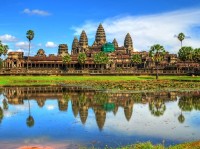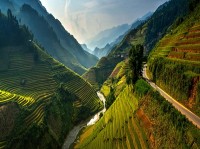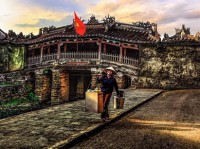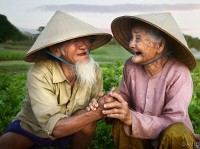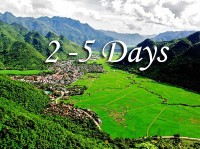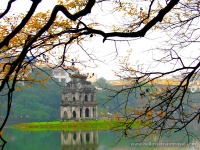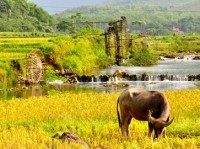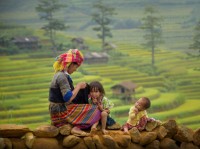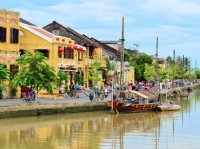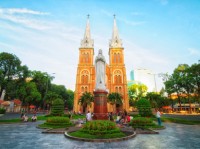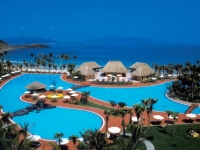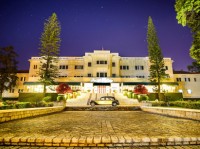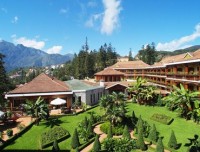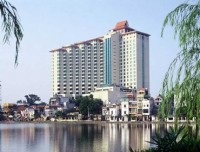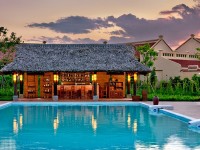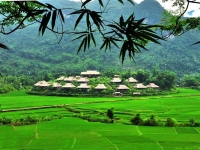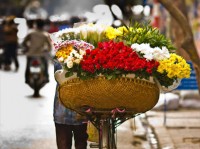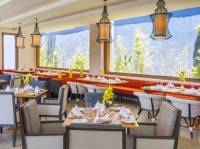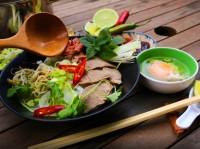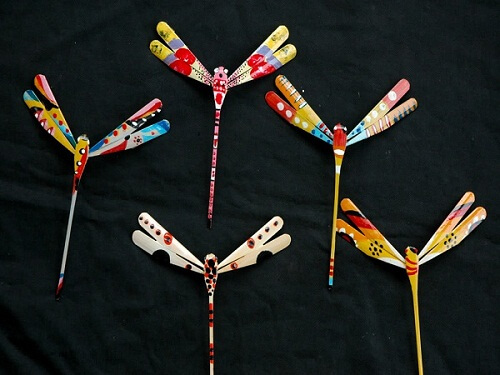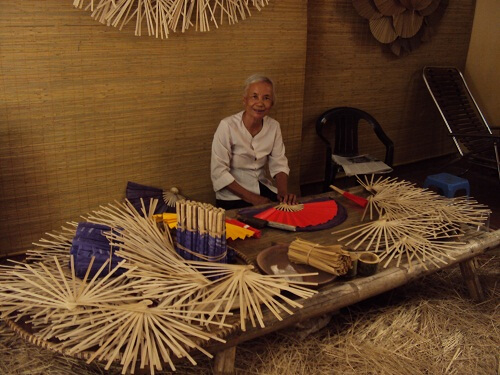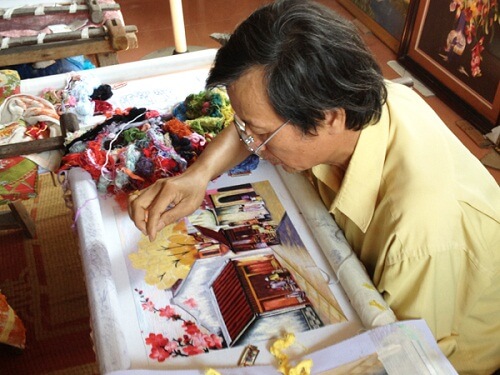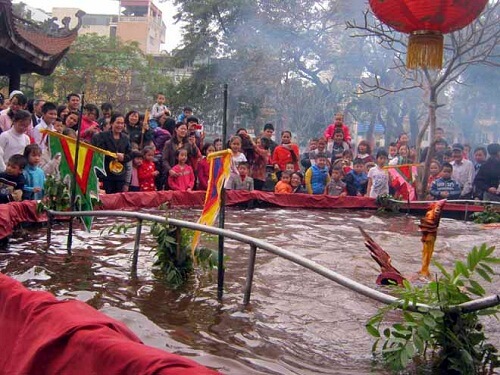Where to go on weekend is an eternal issue of many people. When you are still in a divided mid, then are the traditional trade villages an interesting suggestion for you. Not Bat Trang village or Chuong conical hat village, which are just too familiar, but some not less amazing ones.
THACH XA BAMBOO DRAGONFLY VILLAGE
Colorful bamboo dragonflies in Thach Xa
Located near the Tay Phuong , about 35km from Hanoi, Thach Xa is a village famous for the production of bamboo dragonfly of Thach That suburban district, Hanoi. The bamboo dragonflies here are designed very eye-catching and can balance themselves with their head on small fulcrums. That is why tourists visiting the Tay Phuong temple love this product.
They are called bamboo dragonfly as it is made from bamboo with long dots and only few termites. In general, this product is produced in the following steps: Splitting bamboo, sharpening the body and wings of the dragonfly, making the peak, fitting the wings and decorating. Among them the most difficult one is to fit the wings to the body of the dragonfly, as it requires the worker to calculate carefully so that the dragonfly can perch on the arm. It is only when the dragonfly is balanced that he uses glue to stick it, then comes the decoration.
There are three types of dragonflies based on their size: big, medium and small with the corresponding length 18, 15 and 12. A little bit more sophisticated is to order one like you wish or make one by yourself under the instructions of the local craftsman.
CHANG SON FAN VILLAGE
Nguyen Thi Than - A fan artisan in Chang Son Commune, Thach That District, Hanoi
Chang Son fan is a famous product of the Chang Son commune, Thach That suburban district, Hanoi. The fan production trade is dated back more than a hundred years ago. Since the 19th century, those fans were brought to the galleries in the magnificent Paris by the French. Moreover, the best fan maker in the village will be nominated as “Ba Ho” (feudal honorary rank conferred on a village’s notable or rich man).
The Chang Son fans are famous for their durability and beauty. To get a fan like expected, the worker has to choose the best materials: the bamboo for the production has to be flexible, without moth, the rattan has to be shimmering, long and not broken up when fringing the fan. The paper for the fan is a special type from Dong Ho so that the picture on it can reach its true beauty.
The difficulty to make a fan is to calculate precisely every smallest details on it, which requires extreme caution and the fan must not be affected by the picture on it. The folds need to stand in the center in order not to interrupt the people or landscape in the picture. In an inevitable case, the fan maker represents his talent by painting several connections that can hardly be recognized if not in a close distance.
BAN YEN NHAN SAUCE VILLAGE
The Famous Yen Nhan Crude Soy Sauce
Ban Sauce is a special kind of sauce made in Ban Yen Nhan town, Hung Yen. In the past this sauce was only for the king. Nowadays, it is not only famous in Hung Yen, but also in the whole country.
The material for the production are simple and easy to find: sticky rice, soybean and salt. However, to make a good sauce it is not that easy. The Process includes three main steps: preparing the sticky rice, fermenting the bean and annealing the sauce. The sticky rice has to be soaked, then cooked, dug up and left for two days till it is yellow mould. The soybeans are fried yellow, grinded and soaked in a jar for seven to ten days so that the beans achieve its color. After that two steps, the water from jar and sprouted over the mould sticky rice and mixed thoroughly. Leave it for another day and night so that the mould sticky rice turns yellow again, put it into the bean jar along with salt and air under the sun.
The Ban Yen Nhan sauce has the yellow color like honey and is the indispensible sauce for the Banh Duc, Banh Te,… Furthermore, this sauce makes the dishes more delicious and aromatic.
QUAT DONG EMBROIDER VILLAGE
Artisan Nguyen Xuan Duc (Binh Lang village - Thuong Tin - Hanoi) have worked closely with traditional embroidery over half a century
One of the traditional trade villages in Hanoi that you should not leave out is the Quat Dong embroider village, a famous village dating back to the 17th century. At that time, the embroiderer ò Quat Dong were only making altar-curtains, canopies, parallel sentences and all kinds of turban of sorceress. However, till the beginning of the 20th century, the embroider became more subtle and skilful, it reached a high aesthetic standard as well as diversity of products.
The fabric chosen for embroider have to be the cotton or silk one, and used only with dyed silk fabrics. In particular, for the worshipping objects, the gold lamé and silver thread is required. At first, the worker has to sketch out the frame for the picture on the fabric, and then, depending on the motivation, add or remove some details.
The attractive feature of the embroider picture is not the material or the wide range of topics, but the technique of each embroiderer. For each of his pictures, he needs to have a spirit which is sensitive to the beauty and be very patient. Only then can all the embroidery techniques like connecting dots, recoiling,… cleverly combined and the soul of the work come out of the thread lines.
DAO THUC WATER PUPPET VILLAGE
Dao Thuc water puppet show
Different from other trade villages, the traditional product of Dao Thuc, Dong Anh, Hanoi is a famous genre of play: Water puppet show. The forefather, who handed down the traditional water puppet in this village was Nguyen Dang Vinh.
They are not only producing puppets, the workers here are also participants of each show. In the past, Dao Thuc village played famous plays like “Ba Khi Giao Tro”, “Len Vong Xuong Nuoc”, “Trau chui Ong”,… but nowadays, many other acts have been created to glorify the country like “Tang Hoa Ngay Hoi’, “Ruoc Anh Bac Ho”, “ Hanoi 12 days and nights”…
Visitors in Dao Thuc have the choice of the end of the year of beginning of spring, when it is most popular. At these seasons, in each month, about 20 plays will be performed. In the previous time, the performance is held at the village pond with the stage lighted by oil lamps, torches and had no seats. However, at present time, a beautiful communal house by the pond was built up with convenient seats for guests.
The water puppet precinct of Dao Thuc, Thuy Lam commune, Dong Anh suburban district, Hanoi, is known as repository of traditional culture values and cultural water puppet show for 300 years. Over the Duong bridge turn left into the highway 3 for about 20km, turn right you reach Phu Lo bridge and along the basis of Ca Lo river to Dao Thuc village (Thuy Lam commune, Dong Anh suburban district, Hanoi).
Way instruction
Thach Xa Bamboo dragonfly village: From Hanoi drive about 25km on the Thang Long avenue direction to Thach That, then turn right for another 10km and you have to ask for the Tay Phuong pagoda. When you see the Tay Phuong pagoda plate, turn left. The village is placed right at the feet of the mountain, where also the Tay Phuong pagoda is.
Chang Son fan village: Located on the same way to Thach Xa village, but you do not turn into the Tay Phuong pagoda but to the opposite side.
Ban Yen Nhan sauce village: From Hanoi you drive about 25Km on the highway 5 direction to reach the place.
Quat Dong embroider village: Along the Giai Phong street, crossing Van Dien town to the Voi market you will find a instruction plate on the streetside.
Dao Thuc water puppet village: From the center of Hanoi you cross the Duong bridge, turn left to highway 3, farther to Phu Lo and along the basis of Ca Lo river to reach Dao Thuc village. The whole distance is about 24km.
(Collection)


